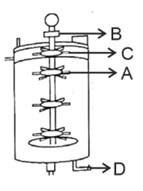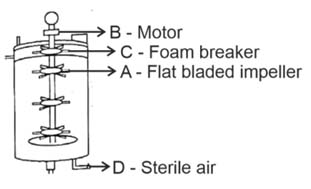Topic Question Set
Q 11
:
Which one of the following equipments is essentially required for growing microbes on a large scale, for industrial production of enzymes? [2019]
Bioreactor
BOD incubator
Sludge digester
Industrial oven
(1)
Q 12
:
The correct order of steps in Polymerase Chain Reaction (PCR) is: [2018]
extension, denaturation, annealing
annealing, extension, denaturation
denaturation, extension, annealing
denaturation, annealing, extension
(4)
A single PCR amplification cycle involves three basic steps, denaturation heating of target DNA to high temperature resulting in separation of two strands, annealing two oligonucleotide primers anneal or hybridise to each single template DNA and extension. Taq DNA polymerase synthesises DNA between primers and primers extend towards each other such that DNA stranded segment lying between the two is copied.
Q 13
:
The process of separation and purification of expressed protein before marketing is called: [2017]
downstream processing
bioprocessing
postproduction processing
upstream processing
(1)
After the formation of the product in the bioreactor it undergoes some processes before a finished product is ready for marketing. The process includes separation and purification of products which are collectively called downstream processing.
Q 14
:
Stirred-tank bioreactors have been designed for: [2016]
purification of product
addition of preservatives to the product
availability of oxygen throughout the process
ensuring anaerobic conditions in the culture vessel
(3)
A stirred-tank reactor is usually cylindrical or with a curved base to facilitate the mixing of the reactor contents. The stirrer facilitates, even mixing and oxygen availability throughout the bioreactor.
Q 15
:
Which of the following is not a component of downstream processing? [2016]
Separation
Purification
Preservation
Expression
(4)
After the formation of the product in bioreactor, it undergoes some processes before a finished product to be ready for marketing. Downstream processing includes separation and purification process. The product obtained is subjected to quality control, testing and kept in suitable preservatives.
Q 16
:
The Taq polymerase enzyme is obtained from: [2016]
Bacillus subtilis
Pseudomonas putida
Thermus aquaticus
Thiobacillus ferrooxidans
(3)
Taq polymerase, generally used in PCR is isolated from thermophilic bacterium Thermus aquaticus.
Q 17
:
An analysis of chromosomal DNA using the Southern hybridization technique does not use: [2014]
electrophoresis
blotting
autoradiography
PCR
(4)
PCR is used only for amplification of DNA. It is not directly involved in Southern hybridisation technique.
Q 18
:
In vitro clonal propagation in plants is characterized by: [2014]
PCR and RAPD
Northern blotting
electrophoresis and HPLC
microscopy
(1)
Clonal propagation can be characterized by PCR and RAPD. The polymerase chain reaction (PCR) technique, generates microgram (µg) quantities of DNA copies (upto billion copies) of the desired DNA (or RNA) segment, present even as a single copy in the initial preparation, in a matter of few hours. RAPD stands for Random Amplification of Polymorphic DNA. It is a type of PCR, but the segments of DNA that are amplified are random. No knowledge of the DNA sequence for the targeted gene is required, as the primers will bind somewhere in the sequence, but it is not certain exactly where. Its resolving power is much lower than targeted, species specific DNA comparison methods, such as short tandem repeats.
Q 19
:
Polymerase chain reaction (PCR) amplifies DNA following the equation. [2025]
(2)
PCR i.e., polymerase chain reaction amplifies DNA as per the equation , where refers to number of cycles. Thus, say, if 3 PCR cycles will run, then i.e., 2 × 2 × 2 8 DNA fragments will be formed.
Q 20
:
Identify the part of a bio-reactor which is used as a foam braker from the given figure. [2025]


A
B
D
C
(4)

Part labelled as C is foam breaker.

